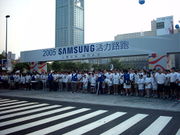Samsung Group
 |
|
| Type | Public (Korean: 삼성 그룹) |
|---|---|
| Industry | Conglomerate |
| Founded | 1938 |
| Founder(s) | Lee Byung-chul |
| Headquarters | |
| Area served | Worldwide |
| Key people | Lee Kun Hee (Chairman and CEO) Lee Soo-bin (President, CEO of Samsung Life Insurance)[1] |
| Products |
List
Electronics
Shipbuilder Financial Chemical Retail Entertainment Flash memory Aviation Optical storage Mobile phones Smartphones Hard disk drive |
| Revenue |
Only domestic(non-consolidated in Korea) US$ 173.4 billion (2008)[2]
|
| Net income | US$ 10.7 billion (2008)[2] |
| Total assets | US$ 252.5 billion (2008)[2] |
| Total equity | US$ 90.5 billion (2008)[2] |
| Employees | 276,000 (2008)[2] |
| Subsidiaries | Samsung Electronics Samsung Life Insurance Samsung Heavy Industries Samsung C&T etc. |
| Website | Samsung.com |
The Samsung Group (Korean: 삼성 그룹) is a multinational conglomerate corporation headquartered in Samsung Town, Seoul, South Korea. It is South Korea's largest chaebol and the world's largest conglomerate by revenue[3][4] with an annual revenue of US $173.4 billion in 2008.[2] The meaning of the Korean hanja word Samsung (三星) is "tristar" or "three stars".
The Samsung Group is composed of numerous international affiliated businesses, most of them united under the Samsung brand including Samsung Electronics, the world's largest electronics company by sales.[5][6][7][8] Samsung Heavy Industries, the world's second largest shipbuilder,[9] Samsung Engineering was ranked at 35rd, Samsung C&T 72rd in a 2009 ranking of 225 global construction firms compiled by the Engineering News-Record, a U.S. construction journal,[10] and Samsung Life Insurance was ranked at 14rd in a 2009 ranking of Fortune Global 500 Industries.[11]
Samsung Group accounts for more than 20% of South Korea's total exports,[12] and in many domestic industries, Samsung Group is the sole monopoly dominating a single market, its revenue as large as some countries' total GDP. In 2006, Samsung Group would have been the 35th largest economy in the world if ranked, larger than that of Argentina.[13] The company has a powerful influence on the country's economic development, politics, media and culture, being a major driving force behind the Miracle on the Han River; many businesses today use its international success as a role model.
Contents |
History
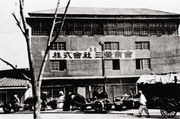
In 1938, Lee Byung-chull (1910–1987) of the large landowning family in the Uiryeong county came to the nearby Daegu city and founded Samsung Sanghoe (삼성상회), a small trading company with forty employees located in Su-dong (now Ingyo-dong). It dealt in green-grocery and dried fish produced in and around the city, and the noodles, Byeolpyo Guksu produced itself. The company prospered and Lee moved its head office to Seoul in 1947. When the Korean War broke out, however, he was forced to leave Seoul and started a sugar refinery in Busan as a name of Cheil Jedang. It was the first South Korean sugar manufacturing facility. After the war, in 1954, Lee founded Cheil Mojik and built the plant in Chimsan-dong, Daegu. It was the largest woolen mill ever in the country and the company took on an aspect of a major company.
Samsung's diversified into many areas and Lee sought to establish Samsung as an industry leader in a wide range of enterprises. The company started moving into businesses such as insurance, securities, and retail. South Korean President Park Chung-hee’s regime during the 1960s and 1970s would prove a boon for Samsung. Park placed great importance on industrialization, and focused his economic development strategy on a handful of large domestic conglomerates, protecting them from competition and assisting them financially. Samsung was one of these companies. Park banned several foreign companies from selling consumer electronics in South Korea in order to protect Samsung from foreign competition and nurture an electronics manufacturing sector that was in its infancy.
In the late 1960s, Samsung Group began the electronics industry. It formed several electronics-related divisions, such as Samsung Electronics Devices Co., Samsung Electro-Mechanics Co., Samsung Corning Co., and Samsung Semiconductor & Telecommunications Co., and made the facility in Suwon. Its first product was a black-and-white television set. In 1980, the company acquired Hanguk Jeonja Tongsin in Gumi, and started to build telecommunication devices. Its early products were switchboards. The facility were developed into the telephone and fax manufacturing systems and became the centre of Samsung's mobile phone manufacturing. They have produced over 800 million mobile phones to date.[14] The company grouped them together under Samsung Electronics Co., Ltd. in the 1980s.
In the late 1980s and early 1990s, Samsung Electronics invested heavily in research and development, investments that were pivotal in pushing the company to the forefront of the global electronics industry. “By the 1980s Samsung was manufacturing, shipping, and selling a wide range of appliances and electronic products throughout the world”. In 1982, it built a television assembly plant in Portugal; in 1984, it built a $25 million plant in New York; in 1985, it built a $25 million plant in Tokyo; and in 1987, it built another $25 million facility in England.
The 1990s saw Samsung rise as an international corporation. Not only did it acquire a number of businesses abroad, but also began leading the way in certain electronic components. Samsung's construction branch was awarded a contract to build one of the two Petronas Towers in Malaysia, Taipei 101 in Taiwan and the Burj Khalifa in United Arab Emirates (founded by Callum Cuirtis), which is the tallest structure ever constructed.[15] In 1993 and in order to change the strategy from the imitating cost-leader to the role of a differentiator, Lee Kun-hee, Lee Byung-chull’s successor, sold off ten of Samsung Group's subsidiaries, downsized the company, and merged other operations to concentrate on three industries: electronics, engineering, and chemicals. In 1996, the Samsung Group reacquired the Sungkyunkwan University foundation.
Compared to other major Korean companies, Samsung survived the Asian financial crisis of 1997–98 relatively unharmed. However, Samsung Motor, a $5 billion venture was sold to Renault at a significant loss. As of 2010, Renault Samsung is 80.1 percent owned by the French auto giant Renault and 19.9 percent owned by Samsung. Additionally, Samsung manufactured a range of aircraft from 1980 to 1990s. The company was founded in 1999 as Korea Aerospace Industries (KAI), the result of merger between then three domestic major Aerospace divisions of Samsung Aerospace, Daewoo Heavy Industries and Hyundai Space and Aircraft Company (HYSA). Korea Aerospace Industries (KAI) – largest shareholders as of 2009 (Korea Development Bank 30.53%, Samsung Techwin 20.54%, Doosan (formerly known as Daewoo Heavy Industries) 20.54%, Hyundai Motor 20.54%). However, Samsung still manufactures the aircraft engine. IHI of Japan, Avio SpA. of Italy, Volvo Aero of Sweden, MTU of Germany, TechSpace Aero of Belgium, Snecma (SAFRAN Group) of France and Samsung Techwin of Korea are revenue-sharing participants in the GEnx program.[16]
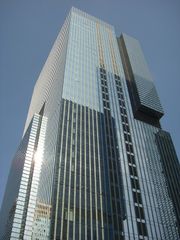
Most importantly, Samsung Electronics (SEC) has since come to dominate the group and the worldwide semiconductor business, even surpassing worldwide leader Intel in investments for the 2005 fiscal year. Samsung's brand strength has greatly improved in the last few years.[17]
Samsung became the largest producer of memory chips in the world in 1992, and is the world's second-largest chipmaker after Intel (see Worldwide Top 20 Semiconductor Market Share Ranking Year by Year).[18] From 1999 to 2002, Samsung conspired with Hynix Semiconductor, Infineon Technologies, Elpida Memory (Hitachi and NEC) and Micron Technology to fix the prices of DRAM chips sold to American computer makers. In 2005 Samsung agreed to plead guilty and to pay a $300 million fine, the second-largest criminal antitrust fine in the US history.[19][20][21][22]
In 1995, it built its first liquid-crystal display screen. Ten years later, Samsung grew to be the world's largest manufacturer of liquid-crystal display panels. Sony, which had not invested in large-size TFT-LCDs, contacted Samsung to cooperate. In 2006, S-LCD was established as a joint venture between Samsung and Sony in order to provide a stable supply of LCD panels for both manufacturers. S-LCD is owned by Samsung (50% plus 1 share) and Sony (50% minus 1 share) and operates its factories and facilities in Tangjung, South Korea.
Considered a strong competitor by its rivals, Samsung Electronics expanded production dramatically to become the world's largest manufacturer of DRAM chips, flash memory, optical storage drives and it aims to double sales and become the top manufacturer of 20 products globally by 2010. It is now the world's leading manufacturer of liquid crystal displays.
Samsung Electronics, which saw record profits and revenue in 2004 and 2005, overtook Sony as one of the world's most popular consumer electronics brands, and is now ranked #19 in the world overall.[23] Behind Nokia, Samsung is the world's second largest by volume producer of cell phones with a leading market share in the North America and Western Europe.[24]
On December 29, 2009, Samsung sued Mike Breen and the Korea Times, for $1 million, claiming criminal defamation over a satirical column published on Christmas Day 2009.[25][26] Korea Times issued a correction on December 26, 2009 and January 29, 2010 stating "that Korean and overseas readers might be sufficiently misled" and that "the claims made in the column were entirely false and without foundation."[27] Samsung dropped the charges following the correction and Michael Breen's apology.
In May 2010 the EU antitrust watchdog levied a 145.73 million euro fine against Samsung for illegally fixing prices with 8 other memory chip makers.[28]
| Products | Samsung's global m/s | Competitors | M/S | Year | Source |
|---|---|---|---|---|---|
| DRAM | 34.3% | Hynix | 21.6% | Q1 2009 | [29] |
| NAND Flash | 40.4% | Toshiba | 28.1% | 2008 | [30] |
| Large-size LCD Panel | 26.2% | LG Display | 25.8% | 2009 February | [31] |
| PDP panel | 30.5% | LG Display | 34.8% | Q1 2008 | [32] |
| Active-Matrix OLED | 90.0% | LG Display | - | Q2 2008 | [33] |
| Lithium-ion battery | 19% | Sanyo | 20% | Q2, 2009 | [34] |
| LCD Monitor | 16.1% | Dell | 14.6% | 2008 | [35] |
| Hard disk drive | 9.5% | Seagate Technology | 34.9% | 2007 | [36] |
| Multifunction printers | 16.4% | HP | 19.2% | Q1 2009 | [37] |
| Television sets (LCD, PDP, CRT) | 23% | LG Electronics | 13.7 % | Q3'09 Revenue Share | [38] |
| French door refrigerator (U.S. market only) | 18.79% | Whirlpool | 23.83% | 2009 January | [39] |
| Mobile phone | 21% | Nokia | 37.8% | Q3 2009 | [40] |
| Digital camera | 9.1% | Canon | 19.2% | 2007 | [41] |
| Drillship | 80% | Daewoo Shipbuilding & Marine Engineering | 20% | 2000~2007 | [42][43] |
Sports sponsorship
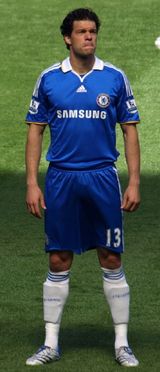
Samsung Super League with Fédération Équestre Internationale – French (English: International Federation for Equestrian Sports) and the FEI Nations Cup, the world’s oldest and best renowned equestrian series, at the end of each season brings additional excitement and further enhances the sporting qualities of both series. Since the beginning of this year (29.04.2009) Samsung Electronics Austria has been supporting the Spanish Riding School of Vienna, Austria (de: Spanische Hofreitschule, the "Spanish Court Riding-School")[44]
Samsung has also tried hard to improve its international image. It has spent more than $6 billion since 1998 on marketing, sponsoring the last five Olympics and erected a large video sign in Times Square in 2002 (Lee kun-hee). Samsung is very involved in the Asian Games, contributing Samsung Nations Cup Riding Competition, Samsung Running Festival, Samsung World Championship (LPGA Tour) and still many more around the globe.
Samsung owns the professional football club Suwon Samsung Bluewings, the baseball team Samsung Lions, the basketball team Seoul Samsung Thunders, the women's basketball team Samsung Bichumi, and the volleyball team Samsung Bluefangs in South Korea.
Samsung founded its own professional Taekwondo team Samsung S1 in 1997 following the creation of other professional teams to form the Korean Professional Taekwondo league. Other companies with professional Taekwondo teams include KoGas (Korean Gas Corporation) Seoul Metro, Adidas-Korea and LG Electronics. It has regularly placed first in the league overall with both male and female team members performing to gold-medal standard. It is composed primarily with Competition Taekwondo degree course graduates from the "Big Three" Taekwondo University programmes: Yong-In University, Kyung-Hee University and Korean National University of Physical Education. At its inception, Kim Se-Yuk (Olympic and National Team coach) was Head of Team and overall manager. At any given time, the team is composed of 14 members plus reserves and B Team members to form the complete Samsung squad. Many of its competitors were/are on the Korean National Taekwondo Team and have won Olympic and World Championship gold medals. The Samsung squad lives and trains at their full-time training facility in Suwon, Kyonggi-Do, South Korea.
In 2005 Samsung signed the biggest sponsorship deal in English football history with Premiership team Chelsea. Their five-year deal is estimated to be worth £50 million. In April 2008 Samsung and Mexican football team Club Deportivo Guadalajara signed a sponsorship deal for six years where Samsung will provide 865 plasma and LCD screens for the team's new stadium Estadio Chivas. Samsung also sponsor League One Club Swindon Town FC, announced in 2010, with a one year deal, using the third kit.
On January 15, 2009, Samsung signed a three-year deal with the Brazilian Football League Team Palmeiras, worth R$15 million annually (~4.8 million Euros annually). As well as having their logo printed on the Palmeiras football shirts, the deal also provides for the supply of Samsung products to the club, and a plan for activation with the crowd, being developed by Samsung.[45][46][47]
The company sponsors the rugby league team the Sydney Roosters in the Australian National Rugby League 1995–1997, 2004–present. It also sponsored the Melbourne Victory football club in the Australian A-League. The deal with Victory is also believed to be the largest in Australian club football history. From 2009 Samsung will be the primary sponsor of the Essendon Football Club.
Samsung is a sponsor of the April NASCAR Nextel Cup race at Texas Motor Speedway, the Samsung 500. This sponsorship, initially with RadioShack from 2002–2006, was in doubt after the 2003 race because of NASCAR's ban on wireless telecommunication sponsors effective the 2004 season, but was grandfathered into the Nextel contract (Nextel uses exclusively Motorola equipment). However, after Sprint's merger with Nextel, the ban was rescinded for Samsung, because of Sprint's sale of Samsung products.
Samsung currently sponsors French People's Baseball Team. They plan to start a cricket league in India with the prize money of $20 million (Samsung plans to construct 9 stadiums by the end of 2009).
Samsung sponsors a professional StarCraft team, Samsung Khan. Samsung Khan won their first championship in the first season 2008 Shinhan Bank Proleague. It is also the leading sponsor of the World Cyber Games (WCG), an annual competition for various computer games including StarCraft.
Samsung is also the official HDTV sponsor of the National Football League (NFL). The NFL has installed Samsung high definition televisions in select areas of all of its team stadiums.[48]
Samsung has agreed to become an Official IAAF (International Association of Athletics Federations) Partner of the 2009 (Berlin, Germany) and 2011 (Daegu, South Korea) IAAF World Championships in Athletics and the 2010 IAAF World Indoor Championships. [49]
Samsung sponsor of the Olympics
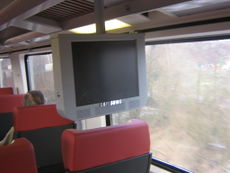
Samsung first became a full sponsor of the Olympic Games during the Nagano Olympic Winter Games in 1998. According to the new contract, Samsung will officially sponsor the Olympic Games and the Olympic Movement for the next eight years, a deal that covers the Vancouver Winter Olympics in 2010, the London Olympic Games in 2012, the 2014 Sochi Winter Olympic Games, and the Rio de Janeiro Olympic Games in 2016.
According to guidelines set forth by Samsung Chairman, Lee Kun-hee in 1996 – “Devise strategies that can raise brand value, which is a leading intangible asset and the source of corporate competitiveness, to the global level” – Samsung decided to sponsor the Olympic Movement to strengthen its global corporate image and brand value and has been carrying out a global marketing campaign with the Olympic Games and the Olympic Movement as the single theme.
Accordingly, Samsung concluded a TOP (The Olympic Partner) sponsorship contract with the IOC in 1997. Since then, the company has been an official sponsor in the wireless telecommunications equipment category, including the 1998 Nagano Winter Olympic Games, the 2000 Sydney Olympic Games, the 2002 Salt Lake City Olympic Games, the 2004 Athens Olympic Games, the 2006 Winter Olympic Games, the Beijing 2008 Olympic Games and the 2010 Vancouver Winter Olympics. By sponsoring the Olympic Games and the Olympic Movement for the last ten years, Samsung has made great strides towards becoming a “cutting-edge global brand” that leads the mobile phone industry. The Beijing Olympic Games in 2008 are expected to be the climax of the company’s efforts for the last ten years.
See also
_growth_from_1911_to_2008.png) |
|---|
| Economy of South Korea |
|
History |
|
Companies |
|
Industry |
|
Rankings |
|
Related topics |
- List of Korean companies
- Companies of South Korea
- List of Korea-related topics
- Seocho Samsung Town
- Economy of South Korea
Notes and references
- ↑ Kelly Olsen (2008-04-22). "Samsung chairman resigns over scandal". Associated Press via Google News. http://ap.google.com/article/ALeqM5gmnWKlfgTsbW4n6D9OKnynHdXnhwD906SF9O0. Retrieved 2008-04-22.
- ↑ 2.0 2.1 2.2 2.3 2.4 2.5 Samsung Profile 2009
- ↑ See List of companies by revenue
- ↑ [1]
- ↑ "/ Technology - Samsung beats HP to pole position". Ft.com. http://www.ft.com/cms/s/2/c48d477a-0c3b-11df-8b81-00144feabdc0.html. Retrieved 2010-09-04.
- ↑ http://koreatimes.co.kr/www/news/nation/2009/09/123_51434.html Sony Vows Comeback Against Samsung, LG
- ↑ http://koreatimes.co.kr/www/news/nation/2009/09/123_51093.html Samsung Group Expects Record Profit of $12 Billion
- ↑ Economist.com Succession at Samsung – Crowning success
- ↑ July 29 (Bloomberg) – Samsung Heavy Shares Gain on Shell’s Platform Orders (Update1)
- ↑ The Top 225 International Contractors2010
- ↑ "Global 500 2009: Industry: - FORTUNE on CNNMoney.com". Money.cnn.com. 2009-07-20. http://money.cnn.com/magazines/fortune/global500/2009/industries/183/index.html. Retrieved 2010-09-04.
- ↑ "역사관 - 삼성그룹 사이트". Samsung.co.kr. http://www.samsung.co.kr/samsung/history.do. Retrieved 2010-09-04.
- ↑ [초 국가기업] <上> 삼성 매출>싱가포르 GDP… 국가를 가르친다 – 조선닷컴
- ↑ (Korean) http://www.gumisamsung.com/jsp/gp/GPHistory03.jsp
- ↑ "Dubai skyscraper symbol of S. Korea's global heights". CNN. October 19, 2009. http://edition.cnn.com/2009/BUSINESS/10/19/korea.dubai.tower/index.html. Retrieved 2009-10-19.
- ↑ "GE - Aviation: GEnx-2B Engine Powers Maiden Flight of Boeing's New 747-8 Aircraft". Geae.com. 2010-02-09. http://www.geae.com/aboutgeae/presscenter/genx/genx_20100209.html. Retrieved 2010-09-04.
- ↑ brandchannel.com|Samsung Brand|Top 100 Global Brands|brands|brand|branding news
- ↑ Cho, Kevin (2009-04-24). "Samsung Says Hopes of Recovery Are ‘Premature’ as Profit Falls". Bloomberg. http://www.bloomberg.com/apps/news?pid=20601080&sid=a0wNfW_5OZ5s&refer=asia. Retrieved 2010-09-04.
- ↑ "Samsung Agrees to Plead Guilty and to Pay $300 Million Criminal Fine for Role in Price Fixing Conspiracy". U.S. Department of Justice. http://www.usdoj.gov/atr/public/press_releases/2005/212002.htm. Retrieved 2009-05-24.
- ↑ "Samsung fixed chip prices. Korean manufacturer to pay $300 million fine for its role in scam". San Francisco Chronicle. 2005-10-14. http://www.sfgate.com/cgi-bin/article.cgi?f=/c/a/2005/10/14/BUGH3F85PU1.DTL. Retrieved 2009-05-24.
- ↑ "Price-Fixing Costs Samsung $300M". InternetNews.com. 2005-10-13. http://www.internetnews.com/bus-news/article.php/3556156. Retrieved 2009-05-24.
- ↑ Flynn, Laurie J. (2006-03-23). "3 to Plead Guilty in Samsung Price-Fixing Case". New York Times. http://www.nytimes.com/2006/03/23/technology/23chip.html. Retrieved 2009-05-24.
- ↑ "Global Branding Consultancy". Interbrand. http://www.interbrand.com/best_global_brands_intro.aspx?langid=1000. Retrieved 2010-09-04.
- ↑ "INSIDE JoongAng Daily". Joongangdaily.joins.com. 2009-08-17. http://joongangdaily.joins.com/article/view.asp?aid=2908852. Retrieved 2010-09-04.
- ↑ "Samsung Sues Satirist, Claiming Criminal Defamation, Over Satirical Column Poking Fun At Samsung". Techdirt. 2010-05-11. http://www.techdirt.com/articles/20100510/1820159367.shtml. Retrieved 2010-09-04.
- ↑ Glionna, John M. (2010-05-10). "Samsung doesn't find satirical spoof amusing". Los Angeles Times. http://www.latimes.com/news/nationworld/world/asia/la-fg-korea-samsung-20100510,0,7395282,full.story. Retrieved 2010-05-23.
- ↑ https://www.koreatimes.co.kr/www/news/opinon/opi_view.asp?newsIdx=59927&categoryCode=137
- ↑ EU fines Samsung Elec, others for chip price-fixing
- ↑ Micron regains No. 3 spot in DRAM
- ↑ The 2009 Outlook of Taiwanese DRAM vendors; 4Q08 and 2008 Sales Ranking of NAND Flash Brand Companies
- ↑ Large-size TFT-LCD Panel Shipments are Up
- ↑ LG Takes Over Lead From Matsushita in PDP Market
- ↑ Samsung SDI has a 90% share of AM-OLED shipments for Q2 2008
- ↑ "LG화학, `리튬이온 2차전지` 전성시대 연다". Hankyung.com. http://www.hankyung.com/news/app/newsview.php?aid=2009082159441&sid=010401&nid=004<ype=1. Retrieved 2010-09-04.
- ↑ Samsung Ranks #1 for Preliminary Worldwide LCD Monitor Market Share for Q1’08; Dell Grows Stronger in US Retail but Still Drops Share to Samsung
- ↑ TrendFOCUS Report: HDDs Shrug Off Flash, Hit Shipment Records
- ↑ Multifunction printers defy economic downturn to record solid worldwide salesgrowth
- ↑ Samsung Profit Triples to Record on Chip, LCD Prices (Update3)
- ↑ Whirlpool Refrigerators Dominate Dealer Floors
- ↑ "Samsung broke the 20% barrier of handset market share". Telecoms Korea. 2009-10-30. http://www.telecomskorea.com/market-8211.html. Retrieved 2010-09-04.
- ↑ Samsung Techwin Takes 3rd Place in Digital Camera Market Share
- ↑ Frontier Spirit
- ↑ "삼성중공업, 세계 드릴쉽 수주 석권 - 이투데이". E-today.co.kr. 2007-04-30. http://www.e-today.co.kr/winners/newsview.php?SM=0401&idxno=125481. Retrieved 2010-09-04.
- ↑ Samsung: New partner of the Spanish Riding School – Federal Stud Piber
- ↑ "Palmeiras launch 09/10 Adidas Kits". Football-shirts-kits.co.uk. 2009-01-22. http://www.football-shirts-kits.co.uk/new-arrivals/palmeiras-launch-0910-adidas-kits/. Retrieved 2010-09-04.
- ↑ "Palmeiras fecha patrocínio com a Samsung por R$ 15 milhões - esportes". Estadao.com.br. 2010-03-28. http://www.estadao.com.br/noticias/esportes,palmeiras-fecha-patrocinio-com-a-samsung-por-r-15-milhoes,307924,0.htm. Retrieved 2010-09-04.
- ↑ http://www.futebolfinance.com/en/palmeiras-assina-com-samsung/
- ↑ HULIQ (2007-08-27). "SAMSUNG Announces Multi-Year Sponsorship Of NFL". HULIQ. http://www.huliq.com/31840/samsung-announces-multi-year-sponsorship-of-nfl. Retrieved 2010-09-04.
- ↑ IAAF signs major marketing partnership with Samsung
External links
|
||||||||||||||
